An easy one day Porto itinerary for first-time visitors to Portugal.
About the author: Claire is a travel blogger who loves the winter season. She adores the solitude of exploring Europe in the cooler months, and writes all about it on her blog, Europe in winter.
With colourful buildings stacked on winding streets and epic views over the River Douro from every hill, Porto is a magnificent city by any measure.
It might be the second largest city in Portugal, but that doesn’t mean it’s huge: One day in Porto is sufficient to see most of the highlights and live out some of Portugal’s most rewarding travel experiences.
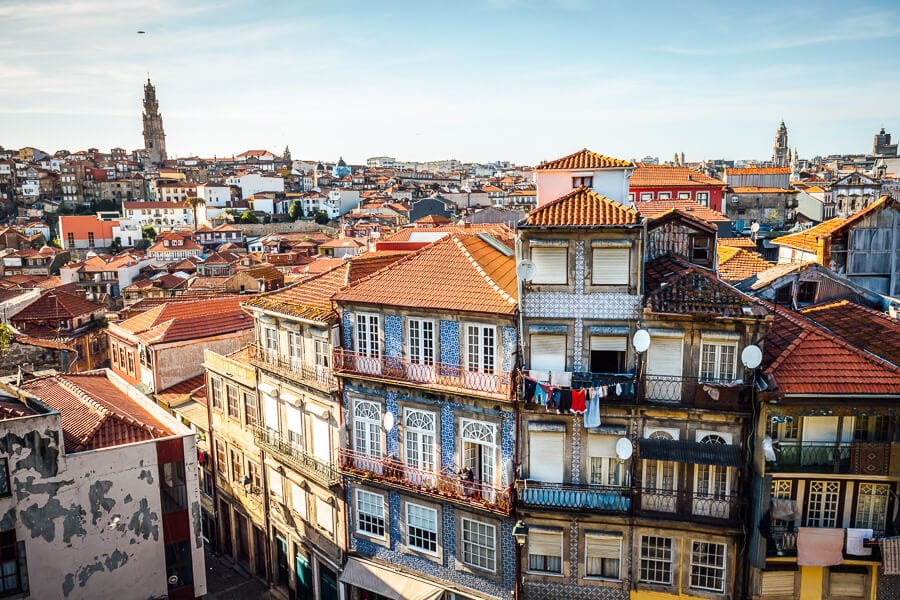
If you’re in Porto for a quick trip – whether it be a city break or a stopover before exploring more excellent destinations in Portugal – this one day in Porto itinerary shows you how you can fit all of the top attractions in.
Please note: This post contains affiliate links, meaning I may earn a commission if you make a purchase by clicking a link (at no extra cost to you). Learn more.
Porto quick links
ACCOMMODATION: The Passenger (hostel); Zero Box Lodge (mid-range); Casa da Companhia (luxury).
AIRPORT TRANSFER: Pre-book a private transfer with meet-and-greet service.
PORTO CARD: Pick up an official Porto Card to cover public transport fares, access to 6 popular museums, and other discounts.
IN A HURRY? Let a local show you the ropes. Best of Porto 3-hour Walking Tour or alternatively this Tuk-tuk Tour of Porto.
BEST PORTO DAY TRIP: Discover the legendary Douro Valley on this full day tour with wine tastings, a river cruise and lunch.
TRAVEL INSURANCE FOR PORTUGAL: Hey Mondo is my preferred provider for comprehensive single and multi-trip travel insurance (save 5% when you book with my link).
One day in Porto itinerary
The handsomest of European cities, Porto is a great place to immerse yourself in Portuguese culture, history and culinary and wine-making traditions. Follow this easy itinerary to squeeze all the best bits out of Portugal’s second-largest city.
Ascend the Clerigos Tower for a city view

Start your day in Porto by getting your bearings from the top of its most famous tower. Clerigos Church and Tower is an instantly recognisable landmark of the city centre, with a history dating back to 1750.
You can ascend its 75-metre-tall bell tower and take in an incredible view of the sprawling city from the top.
Buy your tickets in advance in the summer months – you might not be able to get your desired time slot if you leave it until the last minute!
If you’re visiting Porto in winter, you might not be able to travel all the way to the top of the tower (it’s usually closed in January and February). However, you can still enter and explore the church and museum.
SKIP THE LINE: Pre-purchase your e-tickets for the Clerigos Church Tower and Museum to skip the queue and get access to a bonus audio guide.
Stop by the Capela das Almas
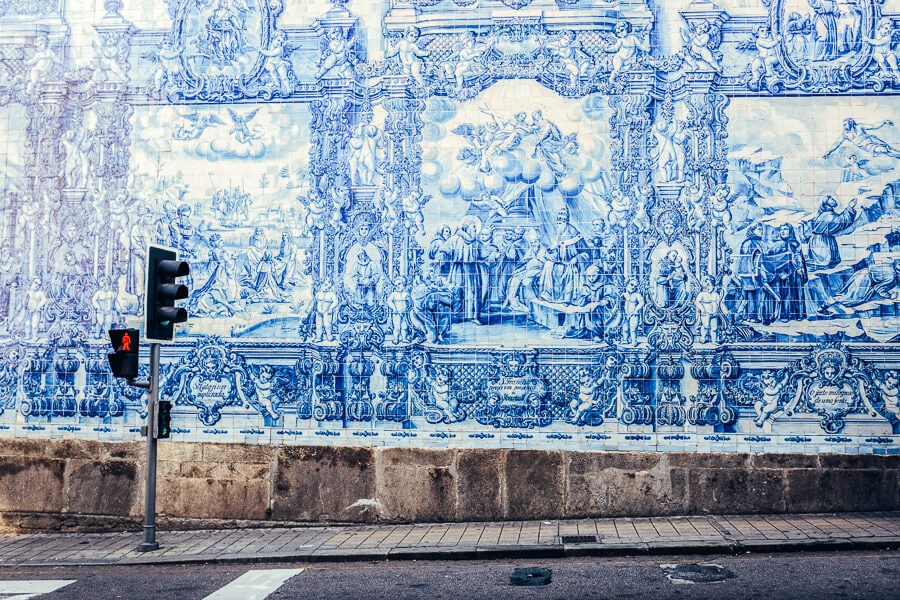
Conveniently located by the Bolhao Metro Station, Capela das Almas (the Chapel of Souls) is worth visiting, even if it’s just for a quick photo stop.
The church is one of the most famous in Porto. It is covered in traditional azulejos, the typical blue and white ceramic tiles of Portugal, that depict various historical scenes.
You’ve no doubt seen photos of this church all over Instagram! Its detailed facade is even more impressive in person.
Visit the two churches of the Igreja do Carmo
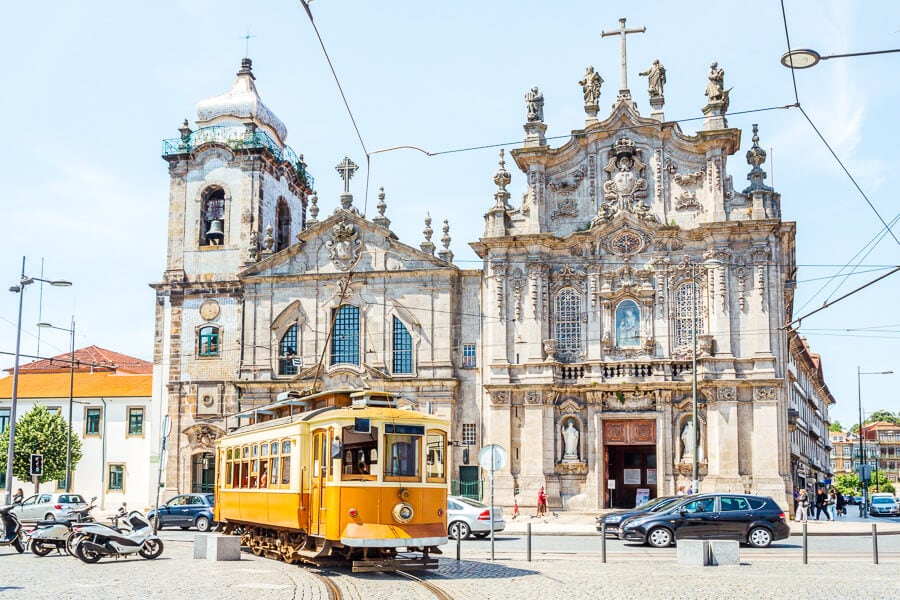
Another must-visit when you’re exploring Porto, Igreja do Carmo is similarly decorated from roof to foundation in beautiful blue azulejos.
It actually consists of two churches and a house – the narrowest in Porto – which is sandwiched between them.
The original church was in fact a convent. At one point, some local men wanted to join the church – the nuns didn’t want to turn them away, but also didn’t wish to permit them into their place of worship. So they gave them permission to build their own church next door instead.
There was an alleyway between the churches, but it ended up being a place where some very un-Christian acts took place! Thus it was ultimately covered over and turned into a house.
You can visit both churches and the house together. Don’t forget to snap plenty of photos of the outside, too!
Go inside the magical Livraria Lello

British author J.K. Rowling lived in Porto for a brief spell (pardon the pun), and subsequently the city – and country in general – inspired a lot of details woven into the Harry Potter series.
For instance, Portugal once had a dictator called Salazar, whom Salazar Slytherin was very likely named after!
Rowling has denied the fact that she was inspired by Livraria Lello, one of the oldest bookstores in Europe, when penning her tomes. Yet it remains very magical-feeling and draws in tourists by the hundreds who see obvious similarities between the curving staircases and the halls of Hogwarts.
You can either admire it from the outside or enter for 5 Euro, which you can redeem off the price of a book. For 15 Euro, you get priority access plus a book to take home. A novel from the world’s oldest bookshop might just be the perfect Portugal souvenir.
If you do decide to visit Livraria Lello, buy your tickets in advance – this is probably the most popular tourist attraction in the city, and there’s always a huge queue at the door. Vouchers can be purchased online through the official Livraria Lello website – here.
A local guide that I had advised arriving at around 2pm, which is peak lunch time in Porto and therefore less likely to be crowded.
MORE HP, PLEASE: Discover more places from the books on the Highlights & Hidden Gems of Harry Potter Tour of Porto.
Chow down on a classic Porto lunch, Francesinha
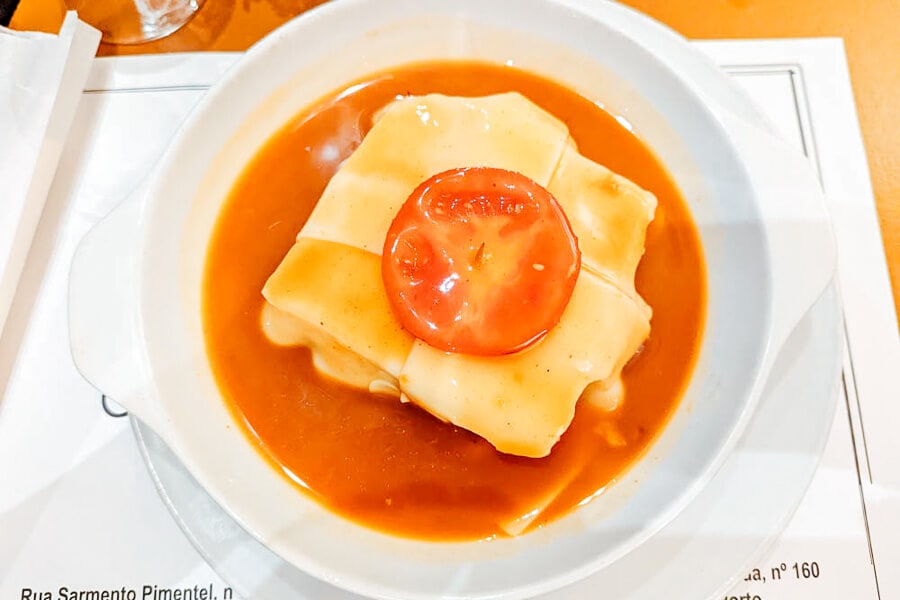
If there’s one food you need to try in Porto, it’s Francesinha. This is a meat sandwich – usually containing ham or sausage – covered in melted cheese, served with a fried egg on top and then doused in a tomato and beer sauce. It’s every bit as rich and calorific as it sounds!
If you’re vegan or vegetarian, don’t worry – Francesinhas Al Forno da Baixa offers plant-based alternatives. Try a toasted sandwich with tempeh, tofu or mushroom – it’s served with melted dairy-free cheese and without the egg.
If you’re visiting as a mixed group, this Francesinha restaurant serves the traditional variety as well.
STILL HUNGRY?: Discover more Portuguese delicacies on a local food tour of Porto. I recommend the 10 Tastings of Porto With Locals.
Admire the azulejos at Sao Bento Train Station

This railway station is a very quick stop, but it’s free and well worth including in your whirlwind Porto itinerary.
If you think you’ve had your fill of azulejo tiles, just wait until you set eyes on the historic São Bento Train Station. One of the most beautiful stations in the world, the entire interior of the main hall is decorated with blue and white azulejos – more than 22,000 individual tiles in total!
The azulejos depict different episodes of Portuguese history, including war scenes and rural landscapes. Jorge Colaço (1868-1942) is the artist responsible for the incredible panels that look absolutely breathtaking in the filtered light.
Visit the Porto Cathedral

Standing at a vantage point overlooking the River Douro, Porto Cathedral is often overlooked compared to other churches in the city. Porto has 70 incredible places of worship all vying for your attention, after all!
However, it’s definitely worth visiting the cathedral, which is also known as Porto Se.
The Romanesque Gothic style building dates back to the 13th century. This area has always been the centre of the city, and when Porto was occupied by the Moors it was a mosque that stood at this strategic location.
Plus, this area of Porto was actually where the whole city was founded.
You can enter the cathedral to admire the architecture and ascend up to the roof for another incredible view of the city and Vila Nova de Gaia.
You can also enter the Bishop’s Palace, known for its immensely grand staircase. This is where the bishops of Porto historically resided.
AUDIO TOUR OPTION: Pre-purchase your tickets here and get access to three audio guides you can use to explore the cathedral and beyond.
Cross the Dom Luis Bridge
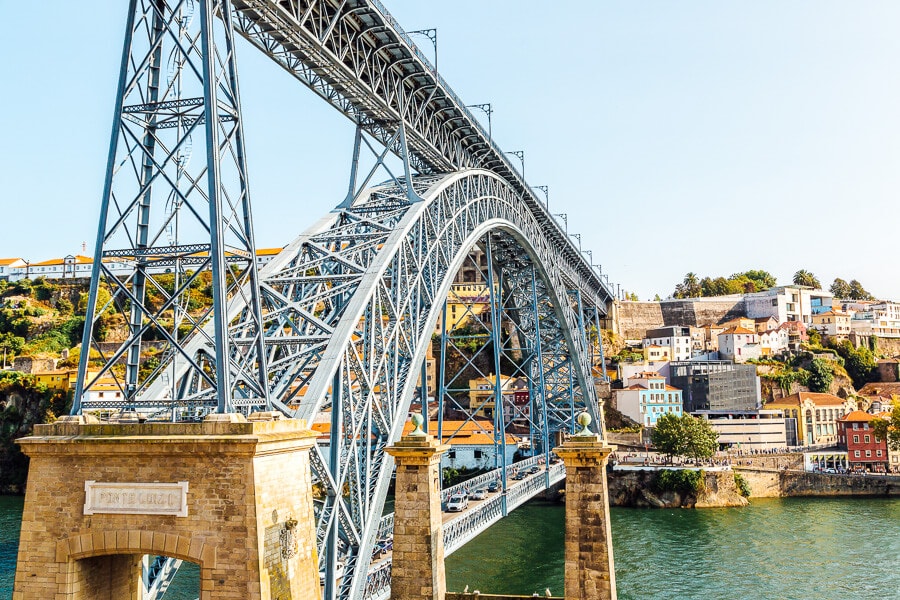
Once you’ve finished at the cathedral, amble down to the banks of the Douro River towards the lively waterfront Ribeira District. A quick wander on the historic Cais da Ribeira reveals spectacular views of Porto’s unique architecture and storybook houses. From here, there is easy access to walk across the Dom Luis Bridge.
Another icon of the city, this bridge spans from Porto to Vila Nova de Gaia – which is actually technically a separate city, but is within walking distance of Porto city centre. Part of The Historic Centre of Oporto, it has been a UNESCO World Heritage Site since 1996.
Just watch out for the metros as you walk across the bridge – they actually trundle down the same bridge as the pedestrians.
If you want a view of Porto from Vila Nova de Gaia, I recommend heading to the Mosterio da Serra do Pilar. This is a monastery with a beautiful viewing platform, from which you can make out all of the city’s best landmarks.
Do a Port wine tasting

Vila Nova de Gaia is famous for two things: views back over to Porto, and Port wine. Port wine was popularised by British tradespeople – they often visited Portugal due to a military alliance in the country, and when Britain was at war with France and Spain, the tradespeople turned to Porto for wine.
They actually started acquiring cod in Northern Europe and bringing it to Porto to trade for wine – which is why you’ll see cod on Portuguese menus so often!
British tradespeople liked the taste (and many people say, the strength!) of the fortified wine, and it became a big hit back in Britain. While it’s wildly popular in the UK nowadays, there’s nowhere better to try Port wine than Porto.
The Duoro Valley is the heart of Portugal wine country. If you don’t have time for a side trip, there are various Port wine cellars dotted around Vila Nova de Gaia in the centre of Porto, some of which are open to walk-ins.
Activities including port tasting, a guided tour of the cellar, a short narration about the history of port or a drinking and dining experience are on offer. If you have a particular activity in mind, I’d recommend checking a website such as Viator and booking in advance.
Alternatively, if you’re happy to explore Vila Nova de Gaia at a more leisurely pace, here are a few stops you can make:
- Espaco Porto Cruz: This is a port cellar with an exhibition/media centre detailing the past and present of Port wine – so you can sip Port while learning about the history.
- Caves Ferreira: This is one of the oldest port cellars in the city, with a history spanning all the way back to 1751.
- Taylor’s Port: One of the most prestigious cellars in the city, here you can learn about Port wine at an exhibition and take a drink out to the terrace.
NEED A DRINKING BUDDY?: Take a Guided Port Wine Walking Tour in Porto city. Featuring a bevy of beverages and traditional Portuguese bar snacks at some of the city’s best cellars and tasting rooms.
Finish your one day in Porto with a Six Bridges sunset cruise

The Six Bridges Cruise is a must-do activity when you’re in Porto, and it’s the ideal way to soak up the city’s evening atmosphere at the end of a busy day.
Porto is famous for its bridges. One was built by Gustave Eiffel, who also built the Eiffel Tower (although it wasn’t the Dom Luis I Bridge, contrary to popular belief – it was actually constructed by Eiffel’s colleague!).
There are a variety of cruises available on Get Your Guide, some of which offer dinner or complimentary drinks, and all of which provide a great commentary of Porto’s main sights.
TOP-RATED SUNSET BOAT TRIP: Enjoy sundowners and snacks on board the ‘Once Upon a Time’ sailboat.
Where to stay in Porto
Zero Box Lodge is one of my favourite places to stay in the city.
It’s not a luxury hotel – the rooms are boxes with no windows or minibars – but they have all the essentials for a cosy stay, including comfortable beds, fresh bed linens, an en-suite bathroom with a rain shower, and air conditioning. Outside of the boxes, there’s a roof terrace with dunk tanks, a sauna and a great restaurant on the ground floor.
If you’re looking for luxury, Casa da Companhia is a deluxe hotel in Porto with a pool, a restaurant, and opulent rooms. Definitely book this one well in advance, especially if you’re travelling in summer.
If a self-contained apartment is your preference, check out this curated list of the best Airbnbs in Porto and Portugal.
Best time to visit Porto
The best time to visit Porto is generally May-June or September to early October. You’ll still have nice warm weather, but it won’t be anywhere near as crowded as high season (July and August).
Despite its location in Southern Europe, Porto can be quite chilly in the winter months – if you’re looking for winter sun, I’d definitely advise Lisbon over Porto.
That said, a lot of Porto’s attractions are indoors and all-weather, and the temperatures are still milder than in northern Europe.
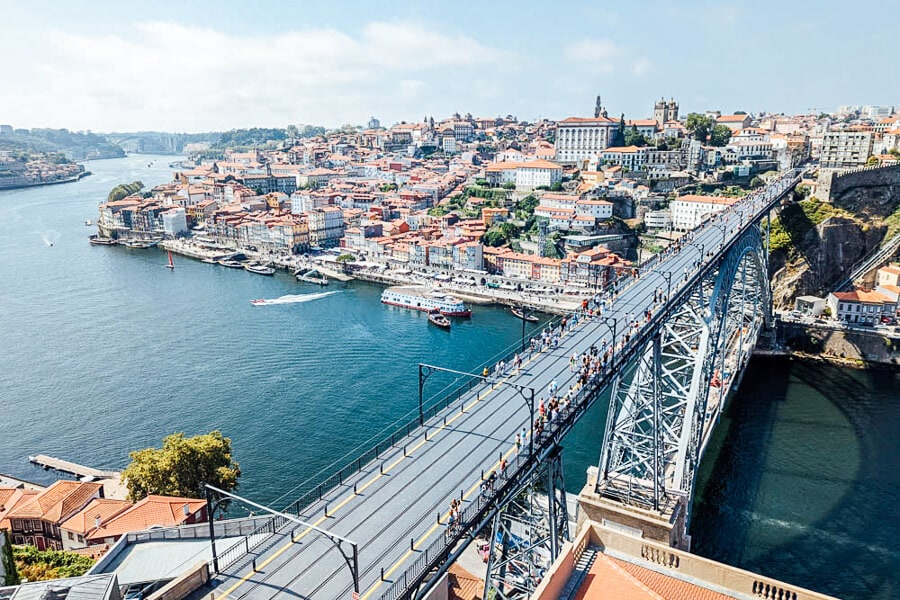
How to get to Porto
Porto is very easy to reach from multiple destinations within Europe – budget airlines such as RyanAir and EasyJet fly to the city daily.
Porto is also well connected to Lisbon by road and rail – you can either use Portugal’s reliable train network or take a FlixBus.
Train connections from neighbouring countries are also available if you’re touring Europe by rail. If you’re flying in from outside Europe, you might find it easier to enter the country via Lisbon.
How to get around Porto
Porto is a very walkable city, although you can also get around by using the extensive metro or bus routes (free with the Porto Card). It’s easy to get from the airport and other terminals by taking the metro or by pre-booking a private transfer.
Uber is also readily available in the city centre and is very affordable, with rides costing as little as 5 Euro.
If you’re spending one day in Porto, hopefully this guide has helped you out!
Porto is a beautiful city with a lot to offer, but thanks to its small size, it is relatively easy to see in one day.
I can’t promise that you won’t want to come back for more though – Porto has a knack for drawing travellers in and making them dream of their return!
More Portugal travel resources
- The most beautiful places in Portugal – your ultimate bucket list
- 28 things to do in Portugal – the country’s best activities and experiences
- 15 best cities to visit in Portugal – for shopping and much more
- Where to stay in Lisbon – best Airbnb apartments
- Where to stay in Portugal – 15 unique accommodations around the country
Hello! Loved reading this post about this magnificent city. I have visited Porto a couple times in the past few years and I believe is the best place for a quick city break.